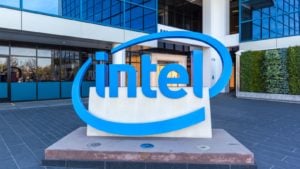Semiconductor industry heavyweight Intel (NASDAQ:INTC) stock has not had a good 2020 so far. Year-to-date, INTC stock is down over 15%.

Santa Clara, California-based Intel is also known as “Chipzilla.” Some of its products include microprocessors, chipsets, embedded processors, flash memory, systems management software and digital imaging products.
Semiconductors are regarded as the brain of modern electronics. Over the past several decades, they have fueled the growth in many industries.
Meanwhile in recent years, the decline of PCs negatively affected the price of Intel stock as the shares have traded in a rather tight range. Now Intel’s management is increasingly on a mission to redefine the company and restructure itself to better match the needs of customers and the growth in data.
Today, we’ll take a closer look at the prospects for Intel stock. Long-term investors searching for dividends may consider buying the dips in INTC shares.
How Intel Makes Money
In late July, Intel announced results for the second quarter. Revenue of 19.7 billion was up 20% year-over-year. Intel reports earnings by two main segments: Data-centric (DCG) and PC-centric. Data-centric revenue grew 34%, accounting for 52 percent of total revenue; PC-centric revenue grew 7% YOY. DCG focuses mainly on three market segments: cloud service providers, enterprise and government, and communication service providers.
PC-centric includes Intel’s PC and mobile-device chip business. The central processing unit is the “compute” in the computer. This segment makes the CPUs.
The chip giant says the data center is at the heart of its transformation from a PC company to one that powers the cloud. Going forward, DCG is expected to be the company’s main growth engine.
Chipzilla controls nearly three-quarters of the CPU market, and Intel processors are the main component – “Intel Inside” – in most of the world’s personal computers and servers. Yet, the worldwide PC market, which is also Intel’s core market, has been flat the past few years.
We are all witnessing the fact that computing is increasingly becoming personal and incorporated into more aspects of daily life. Recent technological advancement can be summarized by growth in data centers, Internet of Things (IoT) and memory. Memory complements data centers and IoT, enabling systems to be faster.
Intel currently holds about 90% share of the data center server market, which has been a consistent growth driver for the company. As the world becomes more connected and focuses on smart devices, there will likely be more demand for data and connectivity. This will fuel growth in Intel’s DCG segment and possibly stock price.
Does Intel Stock Offer Value Now?
According to John VerWey of the Office of Industries, U.S. International Trade Commission (USITC) in Washington, DC, “semiconductors are found in everything from smartphones and computers to automobiles and medical devices. Since Jack Kilby developed the first rudimentary IC for Texas Instruments in 1958, the U.S. chip industry, concentrated in Silicon Valley, has led the world.”
He also says that as of 2018, behind Samsung (OTCMKTS:SSNLF), Intel was the second top-supplier of semiconductors worldwide. Therefore, management is likely to work hard to keep Intel a global leader in the space.
However, the market wants growth and investors are quick to penalize stocks that fall behind. For example, the Q2 report said that Intel’s 7-nanometer chips would be delayed and fall a year behind schedule. As a result, Intel stock sold off, pushing valuation to attractive levels.
For example, its forward P/E stands at 11.11. By comparison, the ratio for Advanced Micro Devices (NASDAQ:AMD) and Nvidia (NASDAQ:NVDA) are 78.13 and 60.98 respectively.
Similarly, P/S ratio for the INTC, AMD, and NVDA stocks stand at 2.78, 13.22, and 25.04. Thus contrarian investors looking for value may want to research Intel stock further.
Passive-income seeking investors would also be interested to know that returning cash to shareholders is a capital allocation priority of management. Its current stock price supports a dividend yield of 2.6%.
Finally, in recent weeks, the board has recently restarted its share-buyback program. The company regards Intel stock price to be undervalued.
The Bottom Line
Growth in the PC market is close to zero and data market presents high volatility. As a result, shareholders in Intel stock were not rewarded well in recent years.
Yet, the Street is hoping management will increasingly offer clients a variety of reliable solutions to optimize their data centers. This will support or even fuel the share price in the new decade. If you also agree with this analysis and are looking for a semiconductor stock with a reliable dividend, then INTC stock needs to be on your watchlist.
As we enter September, markets, and especially tech stocks, may get volatile, which could put some short-term pressure on INTC shares. A move toward the $45-level would make the company a value play in the long run. If you already own Intel stock, you might want to stay the course.
If you are an experienced investor in the options market, you may also consider using a covered call strategy with approximately a two-month time horizon, i.e., Oct. 16 expiry. Such a covered call position would offer some downside protection. You would also be able to participate in a potential up move.
On the date of publication, Tezcan Gecgil did not hold (either directly or indirectly) any positions in the securities mentioned in this article.
The author has worked in investment management for over two decades in the U.S. and U.K. In addition to formal higher education in the field, she has also completed all 3 levels of the Chartered Market Technician (CMT) examination. Her passion is for options trading based on technical analysis of fundamentally strong companies. She especially enjoys setting up weekly covered calls for income generation. She also publishes educational articles on long-term investing.
